In our previous post, we looked at the potential for a downtown rail tunnel for Metrolink Regional Express Rail (RER) service, which would help turn Metrolink into a complimentary service to the Metro rail network. It would reduce the need to transfer, eliminate congestion on Metro, and greatly improve connectivity for Metrolink riders. With that in mind, we should look at what type of service would best suit each of the Metrolink lines, which vary greatly in the type of land use patterns they traverse.
First, it’s good to identify the goal of what exactly we’re trying to do here. Let’s define that in terms of land use and housing affordability, setting aside the obvious environmental benefit of rail electrification. There are several possibilities with Metrolink RER:
- Provide rapid transit (Metro rail) quality service to places that do not currently have it. This suggests focusing on already dense areas and low income areas, which will benefit more and generate higher ridership.
- Reduce travel times between employment centers and more distant suburbs, in order to increase job opportunities available to people who already live in those suburbs.
- Reduce travel times between employment centers and more distant suburbs, in order to reduce gentrification pressures on inner suburbs.
Some of these goals may be at cross purposes; for example, faster and more frequent service to low income areas may make those places more susceptible to gentrification. There are also several types of rail service that could be provided, each of which suits different purposes.
| Type of Service | Stop Spacing | Peak Frequency | Off-Peak Frequency | Best Serves |
| Traditional US Commuter Rail | 3-5 miles or more | 15-60 minutes in peak direction | 60 minutes or more, if any | Above median income suburbs, low density suburbs |
| Zone Express | 5-10 miles or more | 15-30 minutes | 30-60 minutes | Distant suburbs, satellite cities |
| Regional Rail | 3-5 miles or more | 15 minutes | 30 minutes | Dense outer suburbs |
| Rapid Transit | Approximately 1 mile | 5 minutes or less | 10 minutes or less | Dense inner suburbs, low income suburbs |
With that in mind, let’s take a look at each of the Metrolink lines and come up with a general service philosophy for each. In future posts, we’ll look at detailed infrastructure improvements and schedules for each line.
Ventura Line and Antelope Valley Line
The Ventura Line and Antelope Valley Line share a corridor from LA Union Station to Burbank Junction, about 11.4 miles from downtown, and just north of downtown Burbank. From there, the Ventura Line continues to west East Ventura, about 71 miles from downtown LA; the Antelope Valley Line continues north to Lancaster, 77 miles from downtown LA. From these distances, it should be apparent that the level of service appropriate for the outer reaches of these lines is not sufficient for the inner portions, but the level of service appropriate for inner portions of the lines would be excessive for the outer reaches.
To reinforce that initial thought, let’s look at the density and demographics of each portion of the line. Here’s the census tract level density for the Valley and Ventura County.
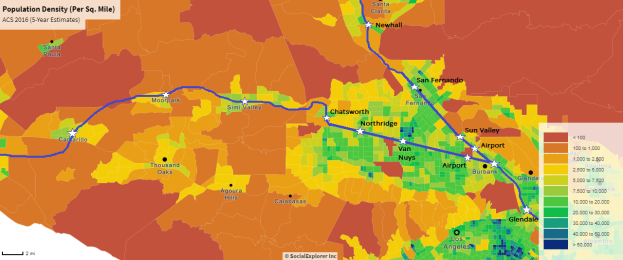
The Valley is much denser than even the near suburbs of Ventura County like Simi Valley and Moorpark, and more consistently dense. Panorama City, just over a mile from the Van Nuys Station, is one of the densest neighborhoods in LA.
Here’s the Santa Clarita Valley and Antelope Valley.
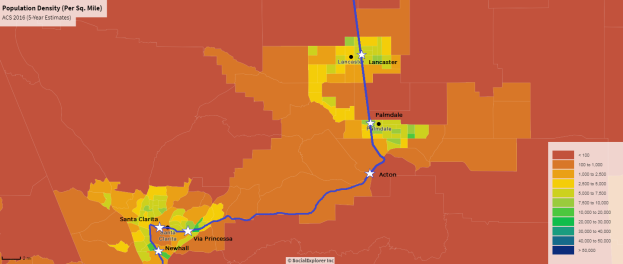
With the exception of a few tracts in Santa Clarita, there’s little real density in these areas. In addition, the prospect of significant density being constructed in these areas is pretty low.
Here’s the census tract level median income for the Valley.
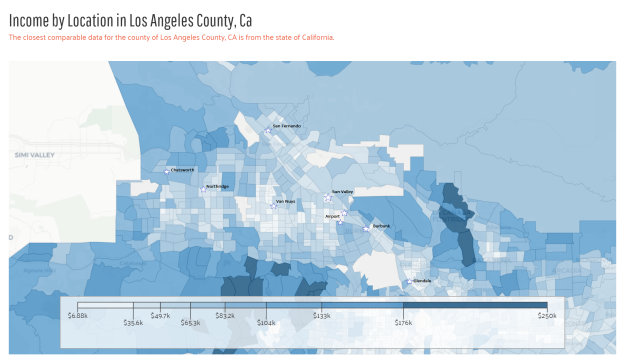
Here’s Ventura County and the Santa Clarita Valley.
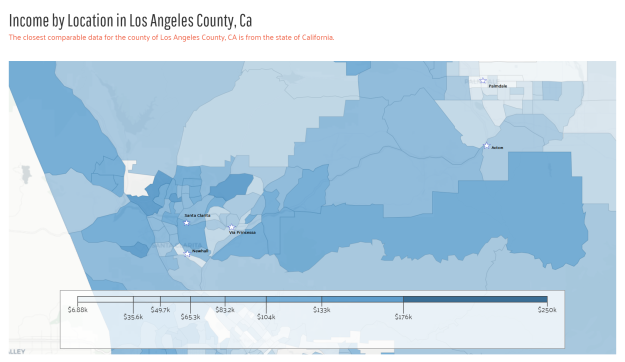
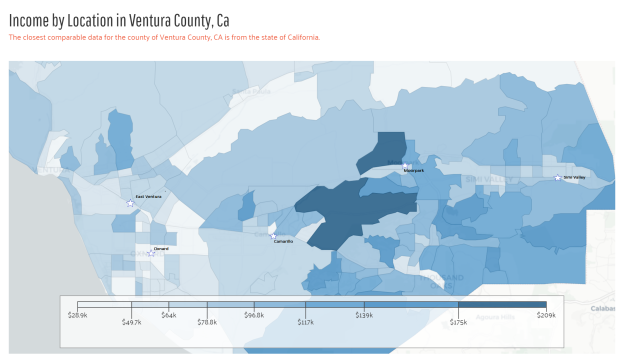
And here’s the Antelope Valley.
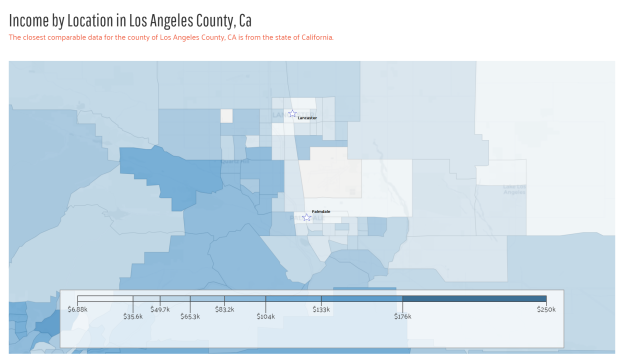
Note that unfortunately I couldn’t manipulate the scales on these graphs, so the Ventura County scale is not the same as LA County. The lowest income tracts in Ventura County are a good bit higher income than the lowest in LA County.
Together the density and demographics suggest the following service patterns:
- The San Fernando Valley is higher density and lower income, and should be served by rapid-transit level service, with infill stations to reduce the stop spacing to about 1 mile.
- Ventura County is lower density and higher income, and should be served by traditional commuter rail service.
- The Antelope Valley is lower density and lower income, and should be served by zone express type service, with trains running express from San Fernando to LA Union Station with only a few stops in between (Burbank and Glendale).
- The Santa Clarita Valley is lower density and higher income, and would be a natural fit for traditional commuter rail service, but will receive zone express type service because of the Antelope Valley.
San Bernardino Line
The San Bernardino Line is an odd duck for Metrolink in that it is the only line that doesn’t share a lot of its corridor with a large volume of freight. It stretches 56 miles from LA Union Station to San Bernardino, traveling through relatively dense areas in the western San Gabriel Valley. The density tapers off east of the 605 but there are still many tracts over 10,000 people per square mile in San Bernardino County, including the distant reaches of the line in Fontana, Rialto, and San Bernardino.
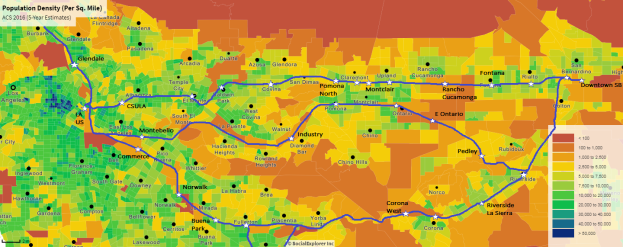
In terms of income, the western San Gabriel Valley is generally moderate income, though there are many low income communities as well. The eastern San Gabriel Valley is higher income, as is the western portion of San Bernardino County. However, incomes are much lower in the eastern portion of the county, with San Bernardino being one of California’s poorest cities.
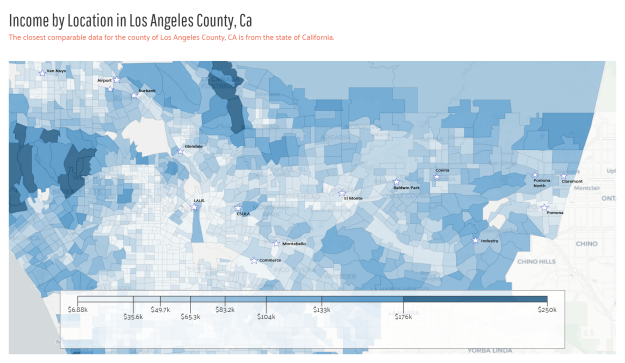
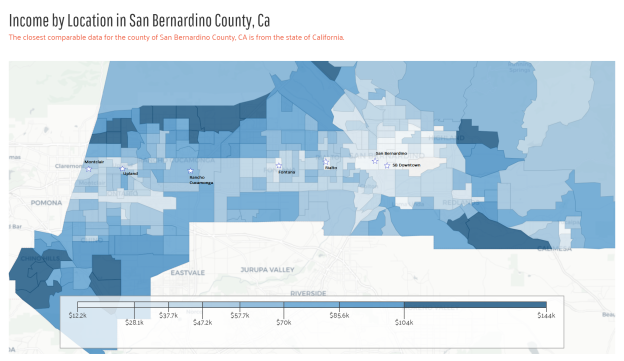
Again, note that unfortunately I couldn’t manipulate the scales on these graphs, so the San Bernardino County scale is not the same as LA County. Together the density and demographics suggest the following service patterns:
- The western San Gabriel Valley (west of the 605) is higher density and moderate income, and should be served by rapid-transit level service, with infill stations to reduce the stop spacing to about 1 mile.
- The eastern San Gabriel Valley (east of the 605) and western Inland Empire (west of the 15) are moderate density and higher income, and should be served by Regional Express Rail type service.
- The eastern Inland Empire (east of the 15) is moderate density and lower income, and should still be served by Regional Express Rail type service.
Put together this would be something like Seoul Metro Line 1. Since this line exists in almost total isolation from other Metrolink lines and freight service, there are some tantalizing future possibilities – with conversion for through running with the Purple Line being perhaps the most appealing.
Orange County Line
The Orange County Line is one of the most unique and interesting rail lines in the country. It is the core transit line connecting Orange County and Riverside County, with over 5 million people, to downtown LA. It is also a part of the LA to San Diego (LOSSAN) Corridor, an important intercity route and the second busiest Amtrak route after the Northeast Corridor. The southern limit of the line in San Clemente (ignoring Oceanside for our purposes here) is only 65 miles from downtown LA, closer than the ends of the Ventura and Antelope Valley Lines, with major secondary cities in Anaheim (31 miles), Santa Ana (36 miles), and Irvine (46 miles).
However, the 25-mile portion between LA and Fullerton is also part of BNSF’s transcontinental mainline freight railroad, probably making it the highest freight volume commuter line in the country, if not beyond. In addition, while Southeast LA County is densely populated, the portion of the corridor between downtown LA and Orange County largely travels through industrial areas with very low density in the immediate vicinity. Due to the high demand for industrial space in SoCal, the industrial areas along the line are not underutilized, and the prospect for greatly increased density is probably small. Compare density in LA to Orange County.

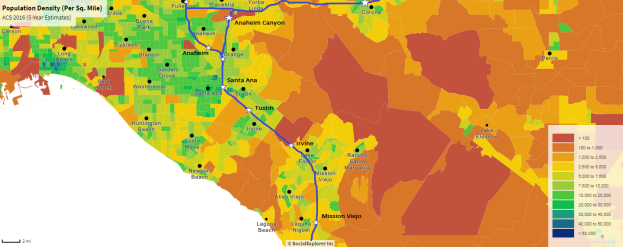
The densest part of the corridor is Orange County from Irvine north. Note that significant development has been occurring in Irvine and mapped densities there are probably a good bit too low. The densest parts of Orange County, in Santa Ana, approach the density of the densest parts of the San Fernando Valley. South of Irvine there is still some density but the development pattern is more like Santa Clarita.
In terms of demographics, while Southeast LA County is generally working class, the corridor passes through portions that are more middle class or are actually too sparsely populated to generate reliable data.
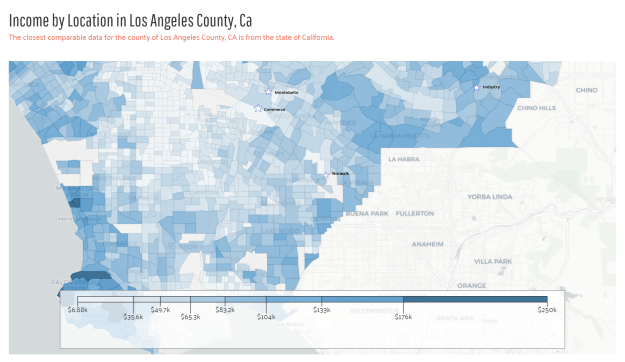
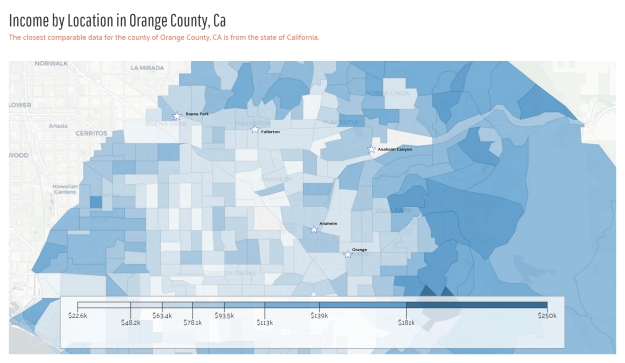
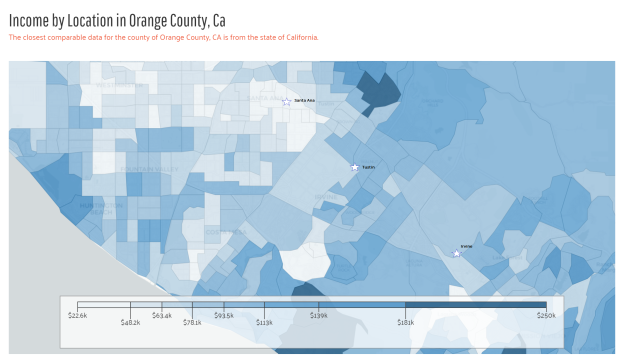
In Orange County, the corridor generally passes through middle income areas to the north and high income areas to the south. The exceptions are significant working class populations in Anaheim and Santa Ana.
Adding it all up, the patterns suggest a strong Regional Express Rail type service between LA and Irvine, with stop spacing of 3-5 miles and 15 minute peak frequency. Some infill stops are warranted, but not every mile like in the Valley. Infill stops should focus on connections to other strong transit corridors, service to job centers like Irvine, and denser stop spacing in high density areas like Santa Ana.
South of Irvine, density drops, incomes rise, and jobs are more dispersed. This area will already be getting higher intercity frequency if the Surfliner expands as hoped, and probably doesn’t need much more than traditional US commuter rail.
91 Line and IE-OC Line
The 91 Line splits off from the Orange County Line at Fullerton, and continues east to Riverside at 61 miles from downtown LA. From there it continues north to San Bernardino, 71 miles from LA via the 91 Line compared to 56 miles via the San Bernardino Line. The 91 Line takes almost all the freight volume from the Orange County Line, meaning that any major expansion of service would likely require significant new track.
There is some density along the line in Corona and Riverside, after a long low density stretch through Santa Ana Canyon. North of Riverside, density drops off until reaching Colton and San Bernardino. Density is greater than Ventura and the Antelope Valley, but less than Orange County or the older suburbs of San Bernardino County.

The line does travel through some lower income portions of Riverside County, with high income areas flanking it on both sides. Incomes are probably lower than the San Bernardino County portion of the San Bernardino line except for the city of San Bernardino itself.
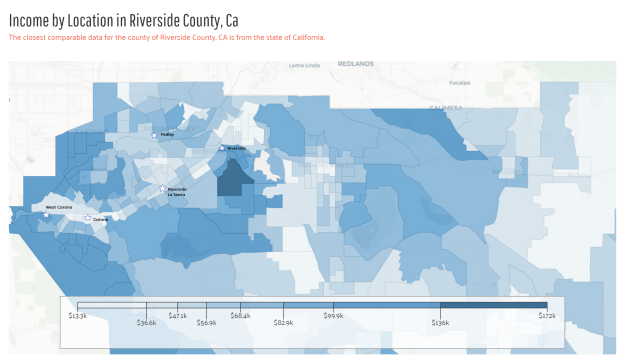
The Inland Empire – Orange County Line (IE-OC Line) shares the whole Riverside County portion of the 91 Line before branching off to the south in Orange County, linking up with the Orange County Line just north of Orange Station and continuing to Irvine. Starting from San Bernardino, Riverside is 10 miles, Santa Ana is 49 miles, and Irvine is 59 miles. With Santa Ana and Irvine as major job centers in their own right, the IE-OC Line serves major suburb to suburb commutes, forming a large wye with the Orange County and 91 Lines.
The setup creates an unusual reverse branching scenario, where service on the legs of the wye can never be as frequent as it is on the trunks. Notably, Anaheim station is located on one of the legs. The Orange County Line is probably stronger than the other two legs of the wye, with the 91 Line/IE-OC Line to Riverside being the weakest of the three trunks.
All taken together, both the 91 Line and the IE-OC Line probably warrant a zone express level of service. That would create Regional Express Rail level of service on the Riverside trunk, which might be too frequent. This could be addressed by having 91 Line trains terminate at Riverside instead of San Bernardino, since the San Bernardino Line will be a much faster ride to downtown LA than the 91 Line for that city. However, it might be beneficial to maintain frequent service between San Bernardino and Riverside themselves.
Riverside Line
What to say about the Riverside Line? I’ve clearly left it for last as the odd man out. The entire corridor from LA to Ontario is UP’s main line transcontinental railroad, meaning any plan for frequent service would require costly upgrades. The corridor is also heavily industrial. West of the 605, it passes through industrial Commerce, with the Commerce/Montebello station getting very low ridership. East of the 605 all the way to Pomona, it passes through the city of Industry, which is flanked by relatively high income neighborhoods. It passes through the huge industrial area of East Ontario and western Jurupa Valley, then through very low density portions of Jurupa Valley on its way to Riverside.
Frustratingly, between Industry and East Ontario, there are two decent nodes (downtown Pomona and downtown Ontario), and Ontario airport. However, given the low potential for the rest of the line, it likely doesn’t make sense to do anything other than traditional commuter rail.
Phasing
Given the existing density and demographics along the system, an electrification program could be phased in over time. Priority should be given to the San Bernardino Line, the San Fernando Valley portions of the Ventura and Antelope Valley Lines, and the Orange County Line to Irvine. After that, the Riverside and IE-OC Lines would follow, and perhaps the Antelope Valley Line. Electrification to the relatively wealthy and low density suburbs in Ventura County and southern Orange County should be the lowest priority unless there are significant changes proposed to land use.
In the future, the whole LOSSAN corridor south to San Diego should be electrified. Service should be frequent enough to justify the cost. I’m less sure about Ventura County and Santa Barbara County, which have much lower populations. As an aside, for air quality reasons, electrification should ultimately include BNSF and UP to points beyond the SoCal Mountains that trap air in the basins. That would probably look something like Lancaster, Victorville, and Palm Springs as limits for electrification.
Given the line’s poor ridership potential west of Pomona, the best thing to do might be to just try to work with UP to get a few more slots, and run a fast express train stopping at Ontario Airport, Ontario, Pomona, Industry, and downtown LA.

Pingback: Today’s Headlines – Streetsblog Los Angeles
It look like there’s not much room to make two tracks on the San Bernardino line west of 605, right?
Yes, you’d have to either take property (something California still has no problem doing for freeway widening projects) or take away freeway lanes.
Restriping could probably get you part of the way there, but then some of the bridges would probably still need to be rebuilt or at least reinforced.
While you’re doing that, would it be possible or advisable to move through freight trains into the 10 freeway median between DTLA and El Monte, and move the passenger trains onto the Alhambra Subdivision? Local freight trains serving customers along the Alhambra sub (are there any?) could continue to operate outside of rush hour.
Pingback: Thursday’s Headlines – Streetsblog USA
What any regional rail plan, including yours, aims to address, is that here in the US, we have rapid transit (frequent service with many stops all day) and we have commuter rail (peak-only with long distances, very wide stop spacing, and park-and-rides). These modes have been considered distinct from each other for a very long time, and because of this, there has long been a “missing middle” so to speak, here in the US, that doesn’t really exist in Europe or Japan, in terms of frequency and stop spacing.
You have proposed to fill some of that gap, especially in terms of off-peak frequency, with regional and zone/express service, but you have still left a gap that I think should be filled.
The gap is between the 5 minute peak/10 minute off-peak frequency of rapid transit, and the 15 /30 of regional rail, and between the 1 mile max spacing of rapid transit and 3 mile minimum spacing of regional/zone express.
In the US, some heavy rail lines (ie BART, WMATA) operate in this gap on the outer reaches of their transit lines, but they are very expensive to build. Some commuter lines (ie Metra Electric / Illinois Central) used to operate there but no longer do thanks to a suburban-biased mission and management. Some lines, like Caltrain, are making a go at re-entering that business.
I think that Metrolink should follow suit. Something along these lines seems like it might be appropriate for the inner segments of the “zone express” service: local service with closer stops, with transfers to express trains available at key stations. This is kind of like what Clem Tillier has proposed for Caltrain service patterns over at his blog.
Pingback: Rail-Related news, Monday, November 5, 2018 | Train Riders Association of California
The 91 line makes a surprisingly fast trip from Riverside to downtown; just about as fast as the riverside line does. I would be more inclined to kill the riverside line entirely, and try to get freight volumes on the more important lines low enough to eschew FRA compliance.
Ontario airport is 2/4 miles (as crow flies/road) from the the San Bernardino line.
Considering the bus trip wouldn’t be much more than going between terminals or from parking lot to terminal at many airports, I’m not inclined to keep the redlands line just because of ONT.
In Munich, the S-Bahn makes extremely tight stops in its central tunnel under the city, more like a subway- would that be worth doing in an LA RER/S-Bahn plan?